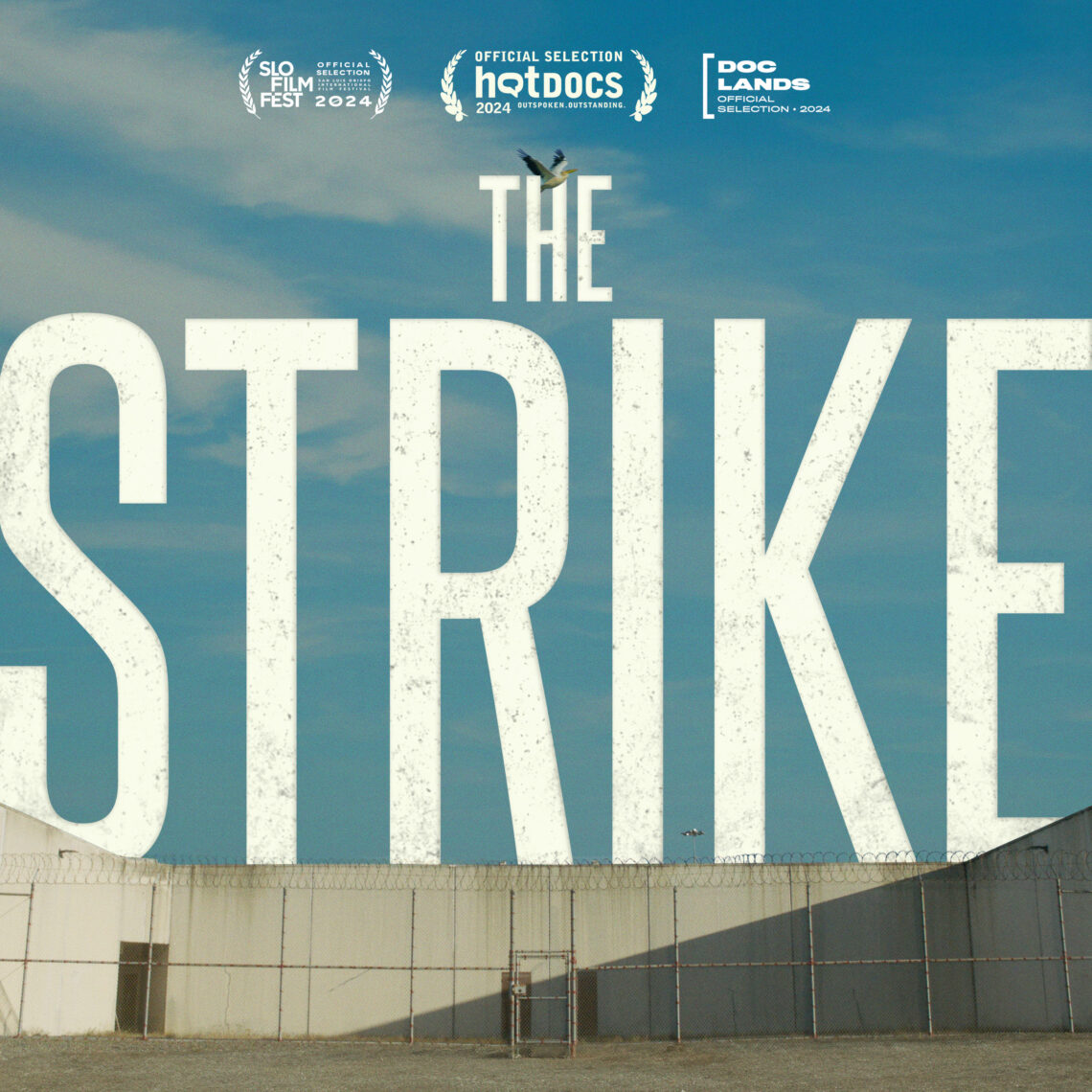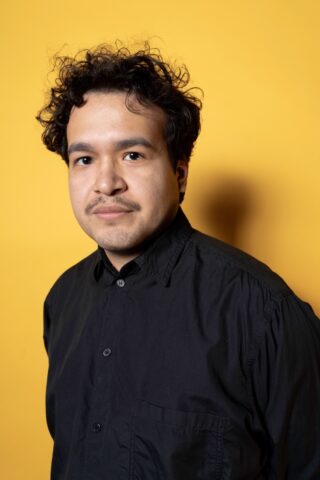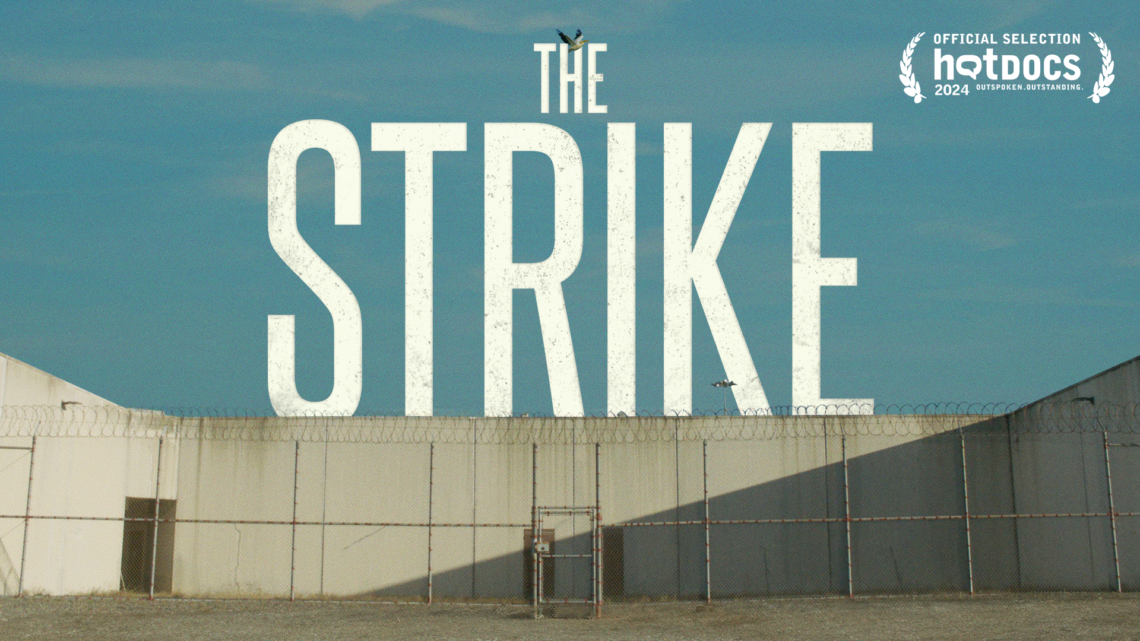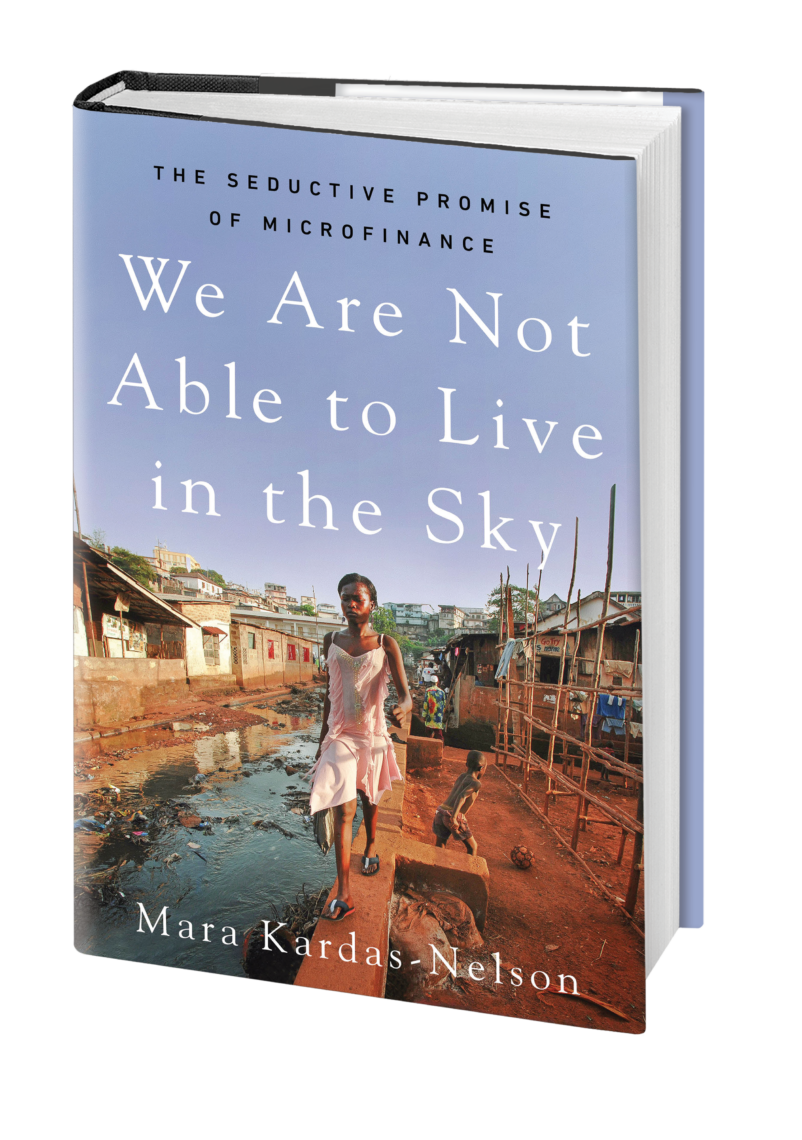
Amid the redwood trees on the California-Oregon border sits one of the most infamous prisons in United States history. Pelican Bay is a labyrinthine construction of solid cement blocks — a supermax prison — opened in 1989 and designed specifically for mass-scale solitary confinement. For decades, it held men alone in tiny cells indefinitely. Then one day in 2013, 30,000 prisoners went on what would become the largest hunger strike in U.S. history.
So describes “The Strike,” a new feature documentary incubated in the school’s Investigative Reporting Program, by JoeBill Muñoz (’19) and Lucas Guilkey (’19) that successfully recounts the uprising through unprecedented access to state prison officials and never-before-seen footage.
“The Strike” had its world premiere at Hot Docs in Toronto in May, followed by festival screenings at DocLands and San Luis Obispo. The documentary sold out four theaters and was awarded the Hot Docs student choice award. It also received critical acclaim in Variety and POV Magazine, and Muñoz and Guilkey were recently featured on KQED’s “Forum.”
Berkeley Journalism’s Marlena Telvick interviewed the filmmakers about the doc via email:
Walk us through the timeline of how this film was made. I understand it started while Lucas was a post-graduate fellow at the Investigative Reporting Program at UC Berkeley.
Lucas: I first had the seed for the idea of the film back in 2013, years before we both started grad school. We became good friends and worked on each others’ thesis films at the J-School and I received a fellowship at the IRP, which gave us fertile ground to properly develop this as a feature film. At the IRP, this project gained a lot of support from many individuals. I mentored J-School students who helped with research and development Robin Estrin (’21), Ravleen Kaur (’20) and Katie Bernstein (’21) and gained community from the other fellows, filmmakers Rachel Witte (’14) and Jameka Autry, and mentorship from professors Geeta Anand and David Barstow, as well as other staff at the IRP.

JoeBill Muñoz
JoeBill: I was working on investigative documentaries for PBS “Frontline” and the Center for Investigative Reporting, with alums Daffodil Altan (’04) and Andrés Cediel (’04). That was the year COVID hit, which certainly brought many twists, diversions and slowdowns. But most importantly, that’s when we formed this creative partnership and began production of the film.
I recall interviewing Lucas about the origins back in 2020 when he said, “This is an idea that’s been percolating for a number of years, ever since I built relationships with the incredible family members of the strikers in 2013.” How did those first contacts start?
Lucas: As a lifelong California resident, I was shocked, along with many others, to learn that our state had been holding people in solitary confinement in windowless concrete cells for decades. That was when the hunger strikes first hit the headlines in 2011 and 2013. I began closely following the story and spent countless hours with family members of the hunger strikers — mostly mothers, daughters, wives and sisters of the strikers in Los Angeles — who saw themselves as the voice of their loved ones. Many were organizing politically for the first time. They spoke at legislative hearings with such powerful love and rage, I knew this story deserved to be told in a full-length documentary.
JoeBill: Years later, Lucas’ contacts gave us the ability to connect with the hunger strikers as they were being released from prison and construct a film based around their first-person stories. That, combined with new reporting, led us to archival footage and on-camera interviews with prison officials, which elevated the film’s storytelling.
The film is framed around the men who bore the brunt of the practice of solitary confinement which some legal experts have called a form of torture. Supreme Court Justice Anthony Kennedy told a House Appropriations subcommittee in 2015 that “solitary confinement literally drives men mad.” But it seems the public wasn’t yet ready to take a hard stand on the issue. What changed, and how did you tell this through the lens of more modern, informed public sentiments about human rights for incarcerated people some 10 years later?

Lucas Guilky
A lot has changed in the mainstream understanding of incarceration in the past 1 to 2 decades. Key court decisions and legislation, at least in California, have reversed some aspects of the era of mass incarceration. But what “The Strike” tries to show is that this shift at the highest echelons of government is often a result of movement from below, from the actions of those most impacted. The Pelican Bay hunger strikes shifted California’s collective understanding of solitary confinement and social movements within prison, not just in California but across the world. At the same time, if you follow California politics today, you’ll see that there are new efforts to swing the pendulum back to reverse some of the accomplishments of recent decades.
Many of the men who were held in prolonged isolation were housed in windowless Security Housing Units (or SHUs). What kind of violations sent them to Pelican Bay — which describes its incarcerated people as “California’s most serious criminal offenders” — ? Walk us through their rights…
There were two ways someone was sent to the SHU. One was for breaking a prison rule, which would give you a set number of months or years in the SHU. The maximum was five years. There was a parallel system that would send some to the SHU indefinitely if they were determined to be associated with a prison gang. This system had very little due process or checks and balances and thousands were sent to the SHU this way — for not something they’d done but for an association or a label. This was a fundamental grievance of the hunger strike. Those in the SHU didn’t have the right to an attorney because it was an administrative process. But many of them became jailhouse lawyers in order to fight their own case. It’s difficult and costly — you have to handwrite your cases (at some point some gained access to typewriters). But jailhouse lawyers eventually partnered with the Center for Constitutional Rights in a class action lawsuit, which went hand in hand with the hunger strikes. The case made the claim to incarcerated people’s fundamental constitutional rights. Spoiler alert: The case did not make it to trial but it was strong enough that the prison system agreed to a settlement that abolished the system of gang validation sending people to indefinite terms in the SHU.
Getting state prison officials on camera is often a road uphill. How did you get them to talk on the record? Did being retired insulate them?
We really spent time doing our due diligence. This was not something we rushed. We were lucky to build a partnership with the investigative reporter Michael Montgomery (Consulting Producer), who JoeBill met while working at “Reveal from the Center for Investigative Reporting.” Michael had reported on the Pelican Bay SHU for over 15 years, and helped us get access to officials who gave us a better understanding of the SHU and how it came to be.
Did the California Department of Corrections and Rehabilitation (CDCR) go on camera? I found information on their website stating, “In response to the directive from Governor Newsom, CDCR is reforming its use of restricted housing. These reforms will take significant steps to limit the use of restricted housing to only those situations where an individual has engaged in violence, which present a direct threat to safety and security of staff and population at CDCR’s institutions.” Did you see evidence of that?
Yes, because of the hunger strikes and class action case, CDCR limited solitary confinement to five years, and one has to commit a behavior violation to be sent to the SHU rather than just being given a label. Five years is still a far cry from the United Nations Standard Minimum Rules for the Treatment of Prisoners — known as the Mandela Rules — which says an individual shouldn’t be held in solitary confinement for more than 15 days. This is the political battle the protagonists of our film are now fighting in the present day.
As producers, how did you get the never-before-seen footage from inside Pelican Bay? The film is described as also revealing the “panic that gripped the highest echelons of state government” in California during the strike itself. How much didn’t the public know at the time?
We knew prison officials were sitting down at the negotiation table with the hunger strikers. We did not know it was being filmed. We definitely never thought we’d find ourselves in possession of that footage. Without giving away too much, the footage we obtained shows a top prison official sitting down with hunger strikers in an attempt to negotiate an end to the hunger strike. The footage and that scene are a very compelling example of how power operates and is wielded within the prison setting.
You both studied under legendary producer Dawn Porter in graduate school and came out swinging right out of school; Lucas’ thesis film, “What Happened to Dujuan Armstrong?”, about the cover up of a young man’s death in county jail, won best documentary at the BAFTA Student Film Awards. And JoeBill’s thesis film “Follow the Sun” was nominated for the David L. Wolper Award at the IDA Awards. How did her guidance help shape how you frame stories? Clearly it’s working…
Dawn is the best! We were so lucky to study with her and Carrie Lozano (‘05) during our time in the J-School’s doc program. Dawn has such amazing storytelling sensibilities, from deciding who to feature as a protagonist to how to hit the necessary storytelling beats in an engaging, yet not overwhelming natural flow. We were so lucky to be sitting in those editing suites with her, learning documentary storytelling and developing our unique voices.
A number of alumni worked on the film. Who were they and what did they do?
Yes, we are so fortunate to be a part of this amazing network of filmmakers. In addition to the graduate students who helped out at the IRP, MJ Johnson (’23) helped out incredibly as a production assistant. Clare Major (’10), Mario Furloni (’11), JP Dobrin (’19) and Rafael Roy (’18) all provided additional cinematography work for us over the years. Katie Bernstein (’21) and Laura Garber (’23) also worked as production assistants, and Christian Lee Collins (’20) helped with sound.
Finally, what did you see in the faces of the many people who have now seen the film? Alexis Madrigal, host of KQED’s “Forum” said, “This film had me sobbing at the end. It’s really, really good.”
We were quite nervous going into our premieres, not knowing what to expect. But we’ve been blown away. At our world premiere in Toronto, we received standing ovations at each screening. It was quite emotional after working on this for so many years. At our Bay Area premiere, the audience clapped for almost the duration of the entire end credits. We were told by some of the protagonists of the film that it was a night that they will never forget. Audience members told us it felt like a historic moment to have our protagonists assembled together on stage, some of them meeting for the first time. The response so far has been incredible, and now we’re working on making sure we can reach as many audiences as possible. We are currently fundraising for our impact campaign, and donations can be made at thestrikefilm.com. Please also follow the film on IG at @thestrikefilm.
——————————
About the filmmakers
JoeBill Muñoz is an award-winning Mexican-American director and producer whose work includes feature documentaries and TV series that have showcased at international film festivals and broadcast on Hulu, Showtime, PBS, and more. From Texas, his love for making documentaries started as a teen, lugging around a VHS camcorder through sweltering football fields to tell the stories of kids like him with big dreams.
JoeBill is the director of The Strike, a feature documentary about a protest against solitary confinement in California prisons. The Strike premiered at Hot Docs in 2024 where it won the student choice award, is currently playing at festivals across the country, and will broadcast nationally in 2025. He has directed short films for Independent Lens (Maletero, Evidence Lost) and NBC (Follow the Sun), which tell the stories of heroic people absent in popular media. As a producer, he spent two years doggedly working on Gabriela Cowperthwaite’s The Grab (Magnolia Pictures, Participant), an investigation into the global powers securing the world’s dwindling natural resources. He was on the team behind the Emmy-winning, Kids Caught in the Crackdown (Frontline), about President Donald Trump’s policy to separate immigrant children from their parents, and most recently has been working with Left/Right Media on series like The Circus (Showtime), The New York Times Presents (Hulu), and an upcoming collaboration with HBO and Words + Pictures.
His independent work has been supported through fellowships from the Sundance Institute, New America, Firelight Media, SFFILM and Dart Center for Journalism and Trauma at Columbia University. He resides in New York City with his partner and poodle.
___________
Lucas Guilkey is an award-winning documentary filmmaker in Oakland, California. He is a student of decolonization, challenging white supremacy, and social movements from below.
He recently directed and produced The Strike, a feature documentary about the hunger strikes against confinement in California prisons, developed in the SFFILM FilmHouse residency and the UC Berkeley Investigative Reporting Program. Currently at festivals, it will be broadcast nationally in 2025. Before that, he was the story producer on Aftershock, a feature documentary about the US maternal health crisis that premiered at Sundance in 2022 and is streaming on Hulu. His directorial debut, What Happened to Dujuan Armstrong?, a short documentary about the coverup of a young man’s death in county jail, won best documentary at the BAFTA student film awards. He is a graduate of the UC Berkeley Graduate School of Journalism and Wesleyan University. In addition to working as an independent documentary producer, you can also find him on a dance floor or the nearest body of water.
Upcoming Events
Dean's Newsletter

March 27, 2024
Quarterly Newsletter From Dean Geeta Anand
Spring 2024 Dear Berkeley Journalism community: With great optimism about the future of our school, I share with you news of the largest gift in the history of Berkeley Journalism:…

Quarterly Newsletter from Dean Geeta Anand
June 15, 2023

Quarterly Newsletter From Dean Geeta Anand
November 30, 2022



